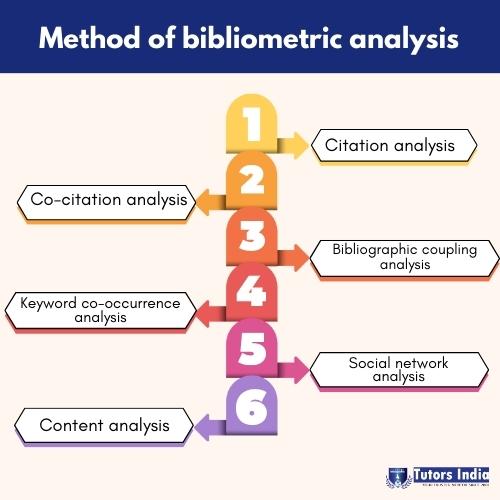What are the different methods of Bibliometric Analysis?
Introduction
Bibliometric analysis is a quantitative method that helps the researcher synthesise past research findings, enabling them to advance their research further. An advantage of using bibliometric analysis is that it can help identify impactful studies, journals, authors, organisations and countries over time from a large volume of bibliographic material. In addition, it also helps in identifying research trends in various disciplines (Lee, 2020). Bibliometric analysis is gaining popularity since it helps reduce study duplication and bias, helping the researchers define the concepts and setting the work (Brika, 2021).
Methods of Bibliometric Analysis
Various methods of bibliometric analysis can be used to analyse the patterns of publication, citation, and collaboration in a particular field of study. Some of the most commonly used methods include:

- Citation analysis: The most common method of bibliometric analysis, citation analysis involves analysing the citations in a particular set of publications to determine the impact of the publications and the extent of their influence on subsequent research. For example, an article is considered influential if it is heavily cited. While citation analysis offers a quick insight into the most important research work in a particular field, the results are often biased towards older articles since newly published articles have relatively less time to be cited.
- Co-citation analysis: This method involves analysing the frequency with which two or more publications are cited together in other publications. This can help identify clusters of related research. Co-citation can be of many types, document co-citation analysis, author co-citation analysis and journal co-citation analysis. Co-citation analysis is the most validated and reliable method since it connects documents, authors and journals. The downside of co-citation analysis is similar to citation analysis since it relies heavily on citation to measure article impact, and new articles take time to be considered significant (Alsolbi, 2022).
- Bibliographic coupling analysis: This method involves identifying the publications that share common references collection, which can help identify related or complementary research areas. Bibliographic coupling offers the advantage of not being heavily reliant on citation and can be used on new articles, emerging fields and smaller subfields. A downside of this method is that it does not identify the most significant articles since it does not identify the works by citation (Tan, 2022).
- Keyword co-occurrence analysis: This method involves identifying the keywords used most frequently in a set of publications and analysing their co-occurrence, which can help identify the most critical topics and themes in the literature. A While it allows analysing the content, it has the drawback that the keywords may be used in different contexts and have different meanings. (Grames, 2019). An example for keyword co-occurrence can include a review on the evolution of educational research topics using bibliometric analysis.
- Social network analysis: This method involves analysing the collaboration patterns among authors and institutions, which can help identify key players and centres of research in a particular field. In addition, this method incorporates mixed method analysis that combines quantitative and qualitative analysis, which is gaining popularity since it gives a deeper understanding of a problem.
- Content analysis: This method involves analysing the content of publications to identify patterns in the research, such as the methods and techniques used, the theoretical frameworks employed, and the research questions addressed (Noorarie, 2020). .
Conclusion
Bibliographic analysis helps the researcher understand the trends and identify impactful journals and authors. Citation, co-citation, bibliographic coupling, keyword co-occurrence, social network and content analysis are the various methods of bibliographic analysis. Each method provides a different perspective on research patterns in a particular field and can be used to answer different research questions. It is vital to choose the appropriate method based on the research question and the available data.
Tutors India has been offering dissertation services for Masters students since 2001. The expert team is proficient in academic writing and ensures high-quality, plagiarism-free work. In addition, it offers unlimited revisions of the completed work and makes sure the students are satisfied.
References
- Lee IS, Lee H, Chen YH, Chae Y. Bibliometric Analysis of Research Assessing the Use of Acupuncture for Pain Treatment Over the Past 20 Years. J Pain Res. 2020;13:367-376.
- Brika SKM, Algamdi A, Chergui K, Musa AA and Zouaghi R (2021) Quality of Higher Education: A Bibliometric Review Study. Front. Educ. 6:666087. doi: 10.3389/feduc.2021.666087.
- Alsolbi, I., Wu, M., Zhang, Y., Joshi, S., Sharma, M., Tafavogh, S., Sinha, A., & Prasad, M. (2022). Different approaches of bibliometric analysis for data analytics applications in non-profit organisations. Journal of Smart Environments and Green Computing, 2(3), 90–104.
- Luc Phan Tan (2022) Bibliometrics of social entrepreneurship research: Cocitation and bibliographic coupling analyses, Cogent Business & Management, 9:1, DOI: 10.1080/23311975.2022.2124594
- Grames, E. M., Stillman, A. N., Tingley, M. W., & Elphick, C. S. (2019). An automated approach to identifying search terms for systematic reviews using keyword CO‐occurrence networks. Methods in Ecology and Evolution, 10(10), 1645–1654.
- Nooraie, R. Y., Sale, J. E., Marin, A., & Ross, L. E. (2018). Social network analysis: An example of fusion between quantitative and qualitative methods. Journal of Mixed Methods Research, 14(1), 110–124.

 Previous Post
Previous Post Next Post
Next Post